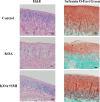Protective effect of Shenmai injection on knee articular cartilage of osteoarthritic rabbits and IL-1β-stimulated human chondrocytes
- PMID: 28587374
- PMCID: PMC5450727
- DOI: 10.3892/etm.2017.4349
Protective effect of Shenmai injection on knee articular cartilage of osteoarthritic rabbits and IL-1β-stimulated human chondrocytes
Abstract
Shenmai injection (SMI) has been widely used as a therapy to treat a number of diseases. However, its anti-osteoarthritic properties have not yet been fully investigated. In the present study, the protective effect of SMI on knee articular cartilage of anterior cruciate ligament transected rabbits and interleukin-1β (IL-1β)-stimulated human chondrocytes was investigated. For the in vivo study, knee osteoarthritis (KOA) was induced in female New Zealand white rabbits by anterior cruciate ligament transection (ACLT) in the knee of right hind limb. Rabbits either underwent sham surgery or ACLT surgery. Out of the rabbits receiving ACLT surgery, half of the rabbits received one 0.3 ml Shenmai intra-articular injection in the knee per week for four weeks, following ACLT surgery. The other rabbits received the same volume of normal saline solution. The cartilage was subsequently collected for histological evaluation. For the in vitro study, cultured human chondrocytes were treated with 10 ng/ml IL-1β in the presence or absence of 5 and 2% (v/v) SMI for 24 h. Nitric oxide (NO) and prostaglandin E2 (PGE2) levels in cell culture supernatant were assessed using a Griess reaction and ELISA respectively. The mRNA expression of cyclooxgenase-2 (COX-2), inducible nitric oxide synthase (iNOS), matrix metalloproteinase (MMP)-1, MMP-13 and tissue inhibitors of metalloproteinase-1 (TIMP-1) in chondrocytes were detected by reverse transcription-quantitative polymerase chain reaction. The results of the current study revealed that treatment with SMI ameliorated cartilage degradation in the ACLT rabbit model, and decreased levels of NO and PGE2. Furthermore, treatment with SMI decreased levels of COX-2, iNOS, MMP-1 and MMP-13 mRNA expression and increased TIMP-1 mRNA expression in IL-1β-stimulated human chondrocytes. These results indicate that SMI suppresses inflammation and ameliorated cartilage degradation, making it a potential and promising therapeutic option to treat KOA.
Keywords: Shenmai injection; anterior cruciate ligament transection; cartilage; chondrocytes; knee osteoarthritis.
Figures




Similar articles
-
Sclareol exerts anti-osteoarthritic activities in interleukin-1β-induced rabbit chondrocytes and a rabbit osteoarthritis model.Int J Clin Exp Pathol. 2015 Mar 1;8(3):2365-74. eCollection 2015. Int J Clin Exp Pathol. 2015. PMID: 26045743 Free PMC article.
-
[In vitro effect of alendronate on chondrocytes and articular cartilage and subchondral bone in rabbit anterior cruciate ligament transection model].Zhongguo Xiu Fu Chong Jian Wai Ke Za Zhi. 2009 Dec;23(12):1474-81. Zhongguo Xiu Fu Chong Jian Wai Ke Za Zhi. 2009. PMID: 20073314 Chinese.
-
[Protective effect of LR-90 on articular cartilage in rabbit model of osteoarthritis].Zhejiang Da Xue Xue Bao Yi Xue Ban. 2016 Mar;45(2):187-94. doi: 10.3785/j.issn.1008-9292.2016.03.12. Zhejiang Da Xue Xue Bao Yi Xue Ban. 2016. PMID: 27273993 Free PMC article. Chinese.
-
Inhibition of cartilage degradation and suppression of PGE2 and MMPs expression by pomegranate fruit extract in a model of posttraumatic osteoarthritis.Nutrition. 2017 Jan;33:1-13. doi: 10.1016/j.nut.2016.08.004. Epub 2016 Sep 2. Nutrition. 2017. PMID: 27908544 Free PMC article.
-
Shikonin inhibits inflammatory responses in rabbit chondrocytes and shows chondroprotection in osteoarthritic rabbit knee.Int Immunopharmacol. 2015 Dec;29(2):656-662. doi: 10.1016/j.intimp.2015.09.014. Epub 2015 Sep 26. Int Immunopharmacol. 2015. PMID: 26395917
Cited by
-
Deciphering the Role of LncRNAs in Osteoarthritis: Inflammatory Pathways Unveiled.J Inflamm Res. 2024 Sep 20;17:6563-6581. doi: 10.2147/JIR.S489682. eCollection 2024. J Inflamm Res. 2024. PMID: 39318993 Free PMC article. Review.
-
The short-term effectiveness and safety of second-generation patellofemoral arthroplasty and total knee arthroplasty on isolated patellofemoral osteoarthritis: a systematic review and meta-analysis.J Orthop Surg Res. 2021 Jun 2;16(1):358. doi: 10.1186/s13018-021-02509-z. J Orthop Surg Res. 2021. PMID: 34078392 Free PMC article.
-
Long noncoding RNA PVT1 promotes chondrocyte extracellular matrix degradation by acting as a sponge for miR-140 in IL-1β-stimulated chondrocytes.J Orthop Surg Res. 2022 Apr 10;17(1):218. doi: 10.1186/s13018-022-03114-4. J Orthop Surg Res. 2022. PMID: 35399100 Free PMC article.
-
Anaphylactoid reactions induced by Shuanghuanglian injection and Shenmai injection and metabolomics analysis.Front Pharmacol. 2023 Jul 6;14:1200199. doi: 10.3389/fphar.2023.1200199. eCollection 2023. Front Pharmacol. 2023. PMID: 37484014 Free PMC article.
-
Comparative efficacy of Chinese herbal injections in patients with cardiogenic shock (CS): a systematic review and Bayesian network meta-analysis of randomized controlled trials.Front Pharmacol. 2024 Feb 27;15:1348360. doi: 10.3389/fphar.2024.1348360. eCollection 2024. Front Pharmacol. 2024. PMID: 38476325 Free PMC article. Review.
References
-
- Aigner T, McKenna L, Zien A, Fan Z, Gebhard PM, Zimmer R. Gene expression profiling of serum- and interleukin-1 beta-stimulated primary human adult articular chondrocytes-a molecular analysis based on chondrocytes isolated from one donor. Cytokine. 2005;31:227–240. doi: 10.1016/j.cyto.2005.04.009. - DOI - PubMed
LinkOut - more resources
Full Text Sources
Other Literature Sources
Research Materials
Miscellaneous
